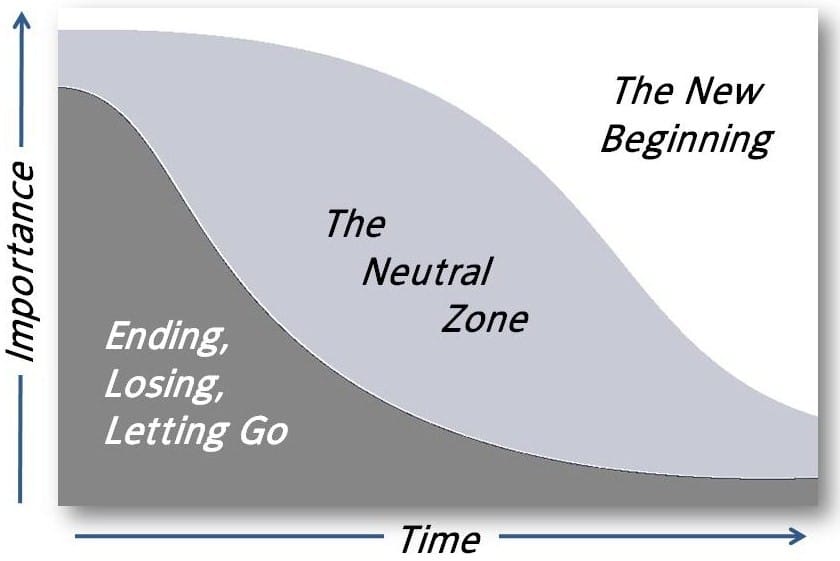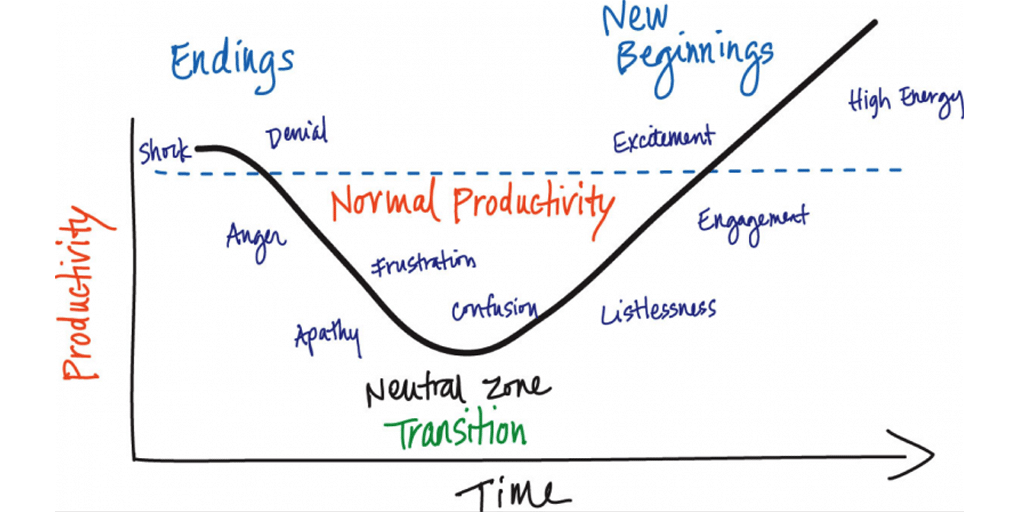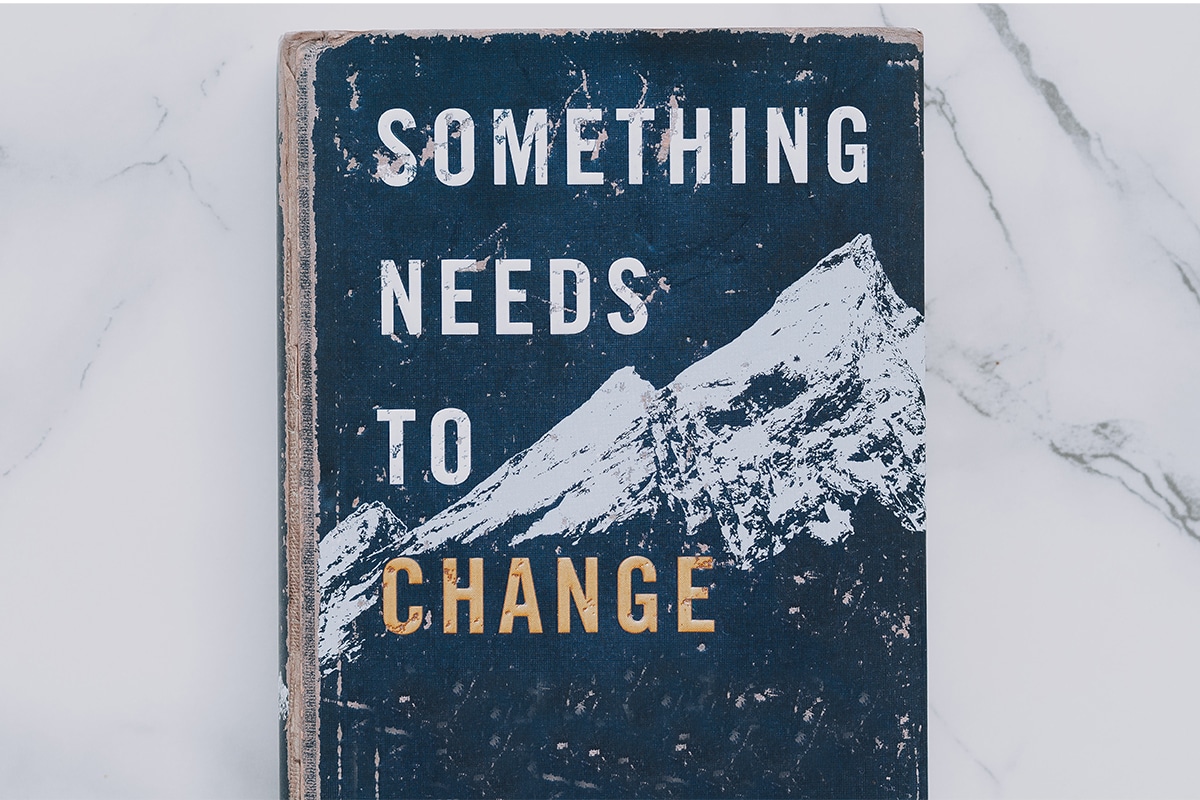The Bridge’s Transition Model was developed in 1991 by William Bridges in his book Managing Transitions: Making The Most Of Change. The model focuses on the concept of Transition rather than of Change, a concept originally developed in a previous book by the same author, published in 1980 with the title Transitions: Making Sense of Life’s Changes.
The idea of focusing on the Transition rather than on the Change is not just a wording question, but rather devises an entirely different approach to Change Management.
Change is the external event or situation that takes place: a new business strategy, a turn of leadership, a merger or a new product. The organization focuses on the desired outcome that the change will produce, which is generally in response to external events. Change can happen very quickly.
Transition is the inner psychological process that people go through as they internalize and come to terms with the new situation that the change brings about. Empathetic leaders recognize that change can put people in crisis. The starting point for dealing with transition is not the outcome but the endings that people have in leaving the old situation behind.
Change is an event but a transition is the process that you go through in response to the change.
William Bridges
Change will only be successful if leaders and organizations address the transition that people experience during change. Supporting people through transition, rather than pushing forward is essential if the change is to work as planned. This is key to capitalizing on opportunities for innovation and creating organizational resilience.
It does this by detailing three stages of transition, each of which the employee must be guided through for the change to be successful:
- Ending, losing, and letting go
- The neutral zone
- The new beginning
The Bridge’s Transition Model

1. Ending, losing, and letting go
Transition starts with an ending. This is paradoxical but true. This first phase of transition begins when people identify what they are losing and learn how to manage these losses. They determine what is over and being left behind, and what they will keep. These may include relationships, processes, team members or locations.
It is a highly emotional phase, where people need to be guided through these powerful emotions to avoid being overwhelmed. Communication about how their skills and knowledge will be transferred to the new activities is key in demonstrating the value of change and mitigating the impact of the more powerful negative emotions.
Fear, anger, denial, uncertainty, frustration are just some examples of the negative emotions that employees might feel, and that can constitute a roadblock onto the Transition.
The focus needs to be on mitigating the effects of these emotions, rather than avoiding them fully. For example, Fear can be managed by helping people understand the positive outcome that the change can bring. Similarly, all other emotions need to be acknowledged, recognized and understood. Which is why it is important, in this phase, that support channels are established for the employees to reach out at need (through mentors, counsellors etc.). Listening to what people feel is critical to be able to intervene and manage the process.
2. The neutral zone
The second step of transition comes after letting go: the neutral zone. People go through an in-between time when the old is gone but the new isn’t fully operational. It is when the critical psychological realignments and repatterning take place. It is the very core of the transition process. This is the time between the old reality and sense of identity and the new one. People are creating new processes and learning what their new roles will be. They are in flux and may feel confusion and distress. The neutral zone is the seedbed for new beginnings.
It is likely to be the time when productivity is at its lowest and your employees most tempted to give up and turn their back to change. This is perfectly normal.
When changes are implemented, people tend to resist because they feel they might have a higher workload, they might be slower because of new process steps and feel less productive. Again, these are all emotions that need to be listened to.
It is also critical to constantly provide people with feedback on the wider context, as well as on their performance within the change process. This will allow them to see things differently, and understand that their fatigue will go away as the change process progresses.
This is the zone where the Transition happens if managed correctly. People are able to understand that instead of being subject to the change, they can become positive actors and transition to a new beginning.
3. The new beginning
Beginnings involve new understandings, values and attitudes. Beginnings are marked by a release of energy in a new direction – they are an expression of a fresh identity. Well-managed transitions allow people to establish new roles with an understanding of their purpose, the part they play, and how to contribute and participate most effectively. As a result, they feel reoriented and renewed.
The last stage is exactly linked to this newly perceived “ownership”: people accept that they can be part of the change process, and transition fully to the new reality. The main aim here is to reinforce the change results, keeping the objectives clear and the pace to achieve.
Creating a system of consistency, which includes training, appraisals, incentives and rewards, is a great way to reinforce the process as a whole. It also recognises the individual contribution to the results of the process as a whole, which is a very relevant step to accomplish.
What’s good about the model
The Bridge’s Transition Model is a great tool to close the gap between leadership and employees, especially in moments where change impacts emotionally people. It critically focuses on the Human Factor, rather than on the purely operational aspects of the Change process. It takes a very personal approach to help everyone adapt to changes by considering their emotions and reactions. Something rare in most of the models we have seen so far.

The focus on the Transition will also improve commitment by employees, and encourage loyalty in the long term, through better performance and an increased team spirit.
What’s bad about the model
As with other similar models (such as ADKAR for example), Bridge’s Transitional Model does not contain actional steps or directions to follow. It is more of a guideline than a step by step guide on implementing change.
However, it can very well be used in conjunction with more directive models, specifically to manage the emotional aspects of the transition journeys that employees have to go through.
Conclusion
This model can be a great tool in the hands of an appropriate leader, as it allows to foster a truly supportive mode in dealing with Change. Its focus on the emotions involved in the change process is great both from awareness as well as a result point of view.
Its key limit is that, unfortunately, we don’t always have the time to manage and direct a full Transition. Despite the best intentions, there are many cases when Change just happens. In these cases, however, the model still provides a formidable framework to put in place tools and processes to manage the negative emotional baggage, and allow for support modes to at least equip some employees through the Transition.
This post belongs to a series of articles related to Change Management. An introductory article: Change Management: The 10 Best Approaches & Models is available, containing links also to all other posts of the series.

Cover Photo by Bluehouse Skis on Unsplash

Hi,
Do you have any real-life examples of where this has worked and not worked in businesses?